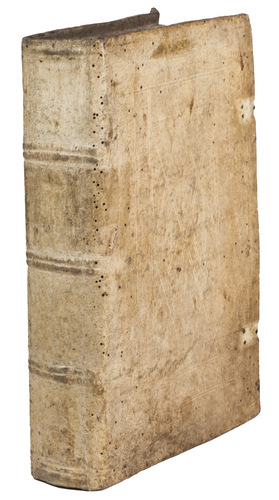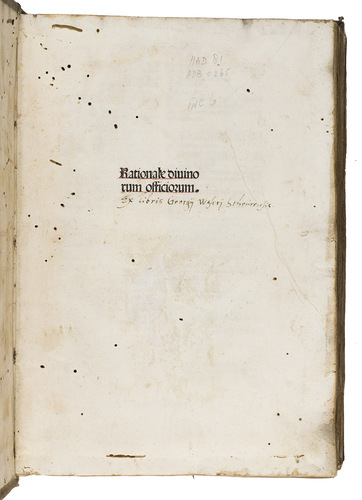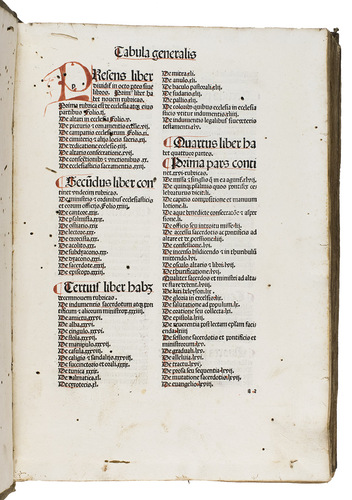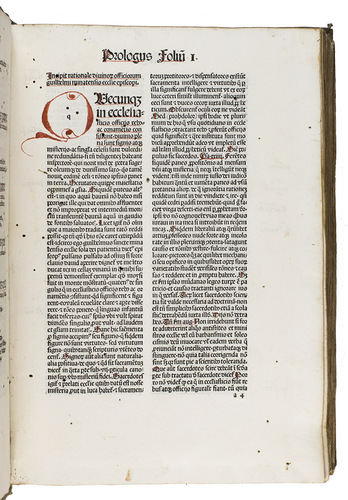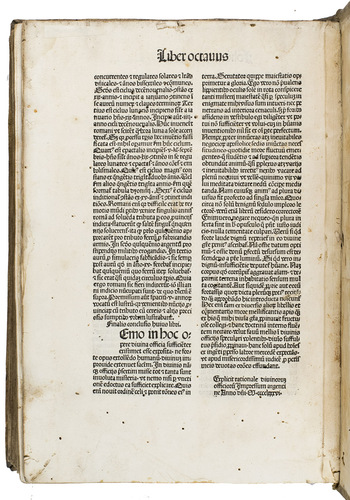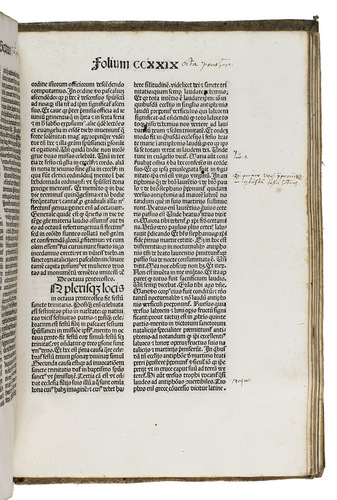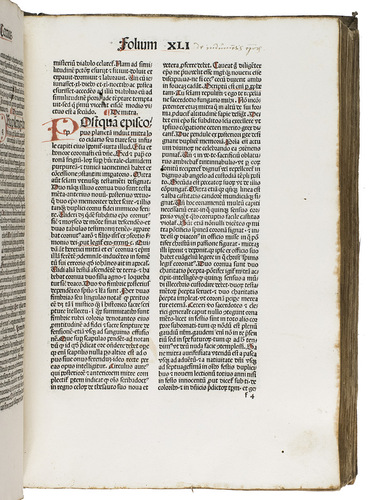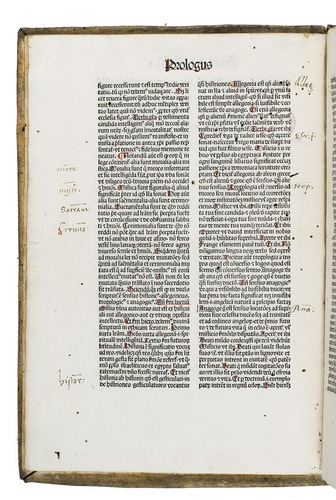DURAND, Guillaume (Guillelmus DURANDUS or DURANTI).
Rationale divinorum officiorum.
Strasbourg, [Johann Prüss], 1486. Chancery folio (32.5 x 22 cm). Printed in 2 columns, with 48 lines to the column. Set in 2 sizes of rotunda gothic types, Prüss types 2 (180G) and 3 (90G), with spaces left (some with and some without printed guide letters) for manuscript initials (1 8-line, 2 7-line, 4 6-line, 3 5-line and numerous 3- and 4-line). From the beginning to h3r these spaced have been filled in with manuscript lombardic initials in red and the text has been rubricated (the first fifth of the book). Contemporary blind-tooled pigskin over wooden (beechwood?) boards by an Augsburg bindery (Eindbanddatenbank workshop w002998, active ca. 1488-1497). [3], 272 ll.
€ 13,500
Written around 1280, the Rationale divinorum officiorum is considered one of the principal sources for the western church liturgy. It focuses on the allegorical interpretation of the liturgy based on Amalario's work, and Duanti is recognized as an excellent compiler. The book is divided into eight volumes and provides an elaborate account of the laws, ceremonies, customs, and mystical interpretations of the Roman Rite. The first volume discusses religious art and architecture, such as the church, altar, pictures, bells, churchyard, and more. The second volume is dedicated to the ministers, while the third volume focuses on vestments. The fourth volume discusses the Mass, the fifth covers the canonical hours, the sixth volume is about the Proprium Temporis, the seventh is about the Proprium Sanctorum, and the eighth covers the astronomical calendar, the manner of finding Easter, Epacts, and more. The Rationale is considered the most comprehensive medieval treatise of its kind, serving as a significant authority on medieval Latin liturgy. It had at least 44 editions during the incunabula age since its first printing in 1459 by Johann Fust and Peter Schöffer in Mainz. Even today, it remains the standard authority for rituals, clothing, and symbolism from the thirteenth century.
Guillaume Durand, Bishop of Mende was an important liturgical author and canonist. Born in 1237 in Puimisson, Provence, a Canonist and prominent liturgical writer of the medieval period, Durandus earned the nickname "Speculator" from his work, Speculum Judiciale. After studying law under Bernard of Parma at Bologna, he went on to teach law at Modena before being summoned by Clement IV to Rome.
Lacking the final blank leaf L10. The leaves in the central part of the book (h4-E2: about 160 leaves) show only one or two small worm holes, but in the leaves before and after (about 60 leaves each) the worm holes gradually multiply as one approaches the beginning and end. In general the bookworms were kind enough to tunnel straight through rather than turning to the side, so that only a handful of leaves show trails and those are few and short (in the worst leaves 2 trails of 1 and 1.5 cm). They did continue through the paste-downs, boards and hinges, leaving numerous very small holes in the pigskin, though the spine remains almost untouched. The bookworms appear not to have grown fat from their feast, because their holes measure only about 1.5 mm in diameter. Aside from the worm holes, the book is internally in very good condition, with only minor marginal stains in the last 5 leaves and an occasional small marginal tear or chip (4 of the 7 leather tabs have torn off, sometimes also affecting the leaf before or after), but none of these few minor blemishes comes close to the text. One can see where two catchplates were once attached to the fore-edge of the binding, and remnants survive of the two leather straps that would have held the clasps. The boards are somewhat rubbed, making it difficult to see details in some of the tooling but thanks to the numerous repetitions of the three stamps and one roll (or possibly two rolls side by side), the binding provides some clear impressions of most and all can be identified. An early edition of an important book on church liturgy, in contemporary blind-tooled pigskin with an interesting provenance and nearly untrimmed, several leaves preserving deckles at the foot (quires b, c and others), fore-edge (quires s, y, z and others) and head (quire K and others). Collijn, Uppsala 514; GW 9131; Goff G431; Hain-Copinger 6491; ISTC id00431000; Pellechet 4508; Polain 1379; USTC 744525; for Scheyern Abbey, its bindery, its library and Georg Waser, see John Thomas McQuillen, In manuscript and print: the fifteenth-century library of Scheyern Abbey, PhD thesis, University of Toronto, 2012 (mcquillen_john_t_2012nov_phd_thesis.pdf), pp. 27-35, 220-229 & 309.
Related Subjects:








